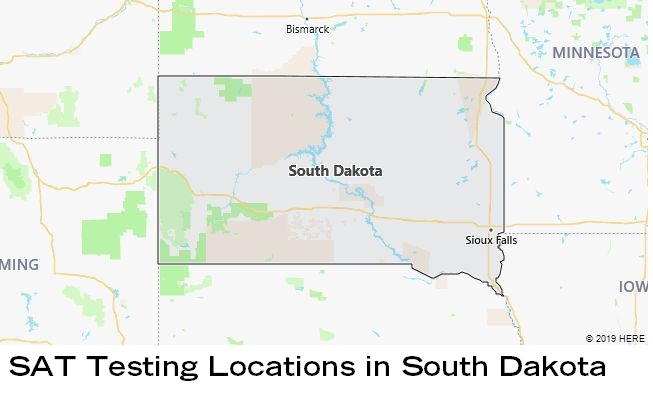According to the College Board, there are 4 test centers for SAT and SAT Subject Tests in South Dakota. Please note that before you register either of the SAT exams, you should choose your test date and test location. Each testing location is affiliated with an educational institution, such as high school, community college, or university. The following test centers administer one or more of SAT tests in South Dakota.

2019 – 2020 SAT Test Dates in South Dakota
- March 9, 2019
- May 4, 2019
- June 1, 2019
- August 24, 2019
- October 5, 2019
- November 2, 2019
- December 7, 2019
- March 14, 2020
- May 2, 2020
- June 6, 2020
- August 29, 2020
- October 3, 2020
- November 7, 2020
- December 5, 2020
SAT Testing Centers in South Dakota
LINCOLN HS
SCHOOL OF MINES + TECHNOLOGY
TF RIGGS HS
WATERTOWN HS

Nature of South Dakota
The state of South Dakota is located in the Midwest of the United States and belongs to the northwestern central states of the United States. The area of South Dakota is 199,905 km 2 (seventeenth place among the states of the USA).
South Dakota is bordered by the states of Minnesota to the east, Iowa to the southeast, Nebraska to the south, Wyoming to the southwest, Montana to the northwest, and North Dakota to the north.
Eastern South Dakota is part of the United States Central Time Zone, while the western counties are part of the Mountain Time Zone.
On the territory of South Dakota, three main physical and geographical regions are distinguished – the lowlands in the east, the Great Plains in the west and the Black Hills mountain range. The natural boundary between the two is the Missouri River, so the eastern counties are often referred to as the East River (“east of the river”), and the western counties as the West River (respectively, “west of the river”).
All of eastern South Dakota is part of the United States Central Plains. Northeast South Dakota is the Minnesota River Valley, a slightly rolling lowland with very fertile soils. To the south, the low plateau of Cote de Prairie rises above the surrounding area, over which many small lakes are scattered. Several national reserves have been created here, protecting vast wetlands. In the southeast of the state (as well as in neighboring Nebraska and Iowa) there is a region of the so-called “dissected plains”, smoothed by a glacier of gentle hills.
To the west, behind the almost flat, but heavily eroded valley of the James River, the slopes of another plateau rise – the Missouri Plateau (or Coteau du Missouri).
To the west of the Missouri River, the terrain gradually rises (up to about 900 meters above sea level) and becomes much more hilly and indented. Much of the East River region is part of the Great Plains stretching from Canada to Texas. In the southwest of South Dakota is the region of “badlands” (“bad lands”). The National Park located here is very popular with tourists due to its unusual and very picturesque landscapes.
Both the East River and the West River of South Dakota are grassy and almost treeless steppes, trees are found here only in river valleys. Bison, deer, pronghorn, coyotes, prairie dogs, dozens of species of birds (including the symbolic bird of the United States, the bald eagle) live on the prairies of the state.
In the west of South Dakota, on the border with Wyoming, there is a region that is sharply different from the rest of the state – the Black Hills (“Black Hills”). This is a relatively small (about 200 km from north to south and 100 from west to east) mountain range, but it is here that the largest US mountains are located east of the Rocky Mountains, including the highest point in South Dakota – Harney Peak (2 208 meters above sea level).
The Black Hills are covered with forests (mostly coniferous) in which elks, various types of deer, pronghorns, mountain goats, bighorns, cougars and other animals live.
Several huge caves are located in the Black Hills, including the world’s second longest (after Mammoth in Kentucky) Jewel Cave (over 250 km) and the fifth longest Wind Cave (over 220 km). Both of them are protected by the state, in addition, it is in this region that the famous Mount Rushmore and the largest of the state-managed Custer Park, known, among other things, for a huge (about one and a half thousand heads) herd of bison, are located.
South Dakota has a continental climate with long, cold winters, hot summers, and short but pronounced springs and autumns. The western regions of the state are arid, in the east there is much more precipitation, mainly in summer.
In the southeast of South Dakota’s largest city, Sioux Falls, average January temperatures range from -16°C to -4°C and July from 16°C to 30°C. In the central districts of the state, in particular in its capital, Pyrrhus, in the coldest month, temperatures usually range from -14°C to -2°C, and in the hottest – from 17°C to 32°C. In the west, in the city of Rapid City, in winter from -12°C to 1°C, and in summer from 14°C to 30°C.
Eastern South Dakota is located on ” tornado alley “, where destructive whirlwinds are often swept by, up to thirty times a year.
